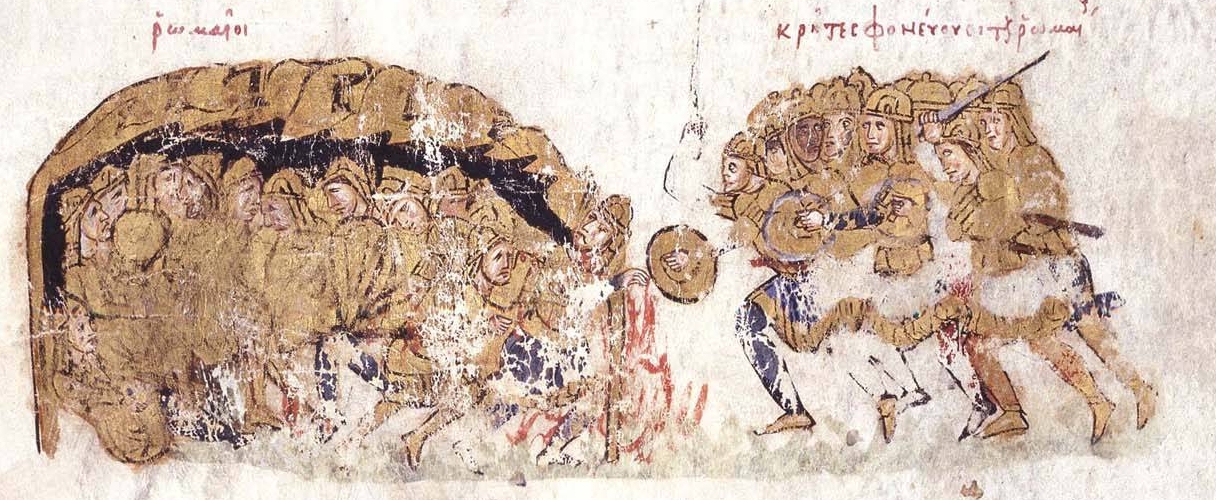Constantine Gongyles on:
[Wikipedia]
[Google]
[Amazon]
Constantine Gongyles ( el, ; ) was a
 Nothing is known of Constantine's early life, except that he came from
Nothing is known of Constantine's early life, except that he came from
Byzantine
The Byzantine Empire, also referred to as the Eastern Roman Empire or Byzantium, was the continuation of the Roman Empire primarily in its eastern provinces during Late Antiquity and the Middle Ages, when its capital city was Constantinopl ...
eunuch
A eunuch ( ) is a male who has been castrated. Throughout history, castration often served a specific social function.
The earliest records for intentional castration to produce eunuchs are from the Sumerian city of Lagash in the 2nd millenni ...
and court official who led a failed expedition against the Emirate of Crete
The Emirate of Crete ( ar, إقريطش, Iqrīṭish or , ''Iqrīṭiya''; gr, Κρήτη, Krētē) was an Islamic state that existed on the Mediterranean island of Crete from the late 820s to the reconquest of the island by the Byzantine Empi ...
in 949.
Biography
300px, The Cretan Saracens defeat the Byzantines. Miniature from the '' Madrid Skylitzes'' Nothing is known of Constantine's early life, except that he came from
Nothing is known of Constantine's early life, except that he came from Paphlagonia
Paphlagonia (; el, Παφλαγονία, Paphlagonía, modern translit. ''Paflagonía''; tr, Paflagonya) was an ancient region on the Black Sea coast of north-central Anatolia, situated between Bithynia to the west and Pontus (region), Pontus t ...
.. The ''Life of St. Basil the Younger'' hagiography indicates that he and his brother Anastasios were relatives of the eunuch Constantine Barbaros, who rose to power at court as a favourite of the powerful '' parakoimomenos'' Samonas
Samonas ( el, , 875 – after 908) was an Arab-born eunuch, who was captured by the Byzantines and became one of the most influential officials of the Byzantine Empire during the first decade of the 10th century.
Biography
Samonas was born in c ...
and of Emperor Leo VI the Wise
Leo VI, called the Wise ( gr, Λέων ὁ Σοφός, Léōn ho Sophós, 19 September 866 – 11 May 912), was Byzantine Emperor from 886 to 912. The second ruler of the Macedonian dynasty (although his parentage is unclear), he was very well ...
(r. 886–912). Constantine first rose to prominence in 913/4, when following the death of Emperor Alexander
Alexander is a male given name. The most prominent bearer of the name is Alexander the Great, the king of the Ancient Greek kingdom of Macedonia who created one of the largest empires in ancient history.
Variants listed here are Aleksandar, Al ...
(r. 912–913), the Empress-regent Zoe Karbonopsina
Zoe Karbonopsina, also Karvounopsina or Carbonopsina, ( el, Ζωὴ Καρβωνοψίνα, translit=Zōē Karbōnopsina), was an empress and regent of the Byzantine empire. She was the fourth spouse of the Byzantine Emperor Leo VI the Wise and th ...
selected him and his brother as her personal councillors. On this occasion, Constantine was raised to the supreme noble rank of ''patrikios
The patricians (from la, patricius, Greek: πατρίκιος) were originally a group of ruling class families in ancient Rome. The distinction was highly significant in the Roman Kingdom, and the early Republic, but its relevance waned aft ...
''.
Constantine Gongyles wielded great influence during the regency of Zoe (914–919), but he fell from power under Emperor Romanos I Lekapenos
Romanos I Lekapenos ( el, Ρωμανός Λεκαπηνός; 870 – 15 June 948), Latinized as Romanus I Lecapenus, was Byzantine emperor from 920 until his deposition in 944, serving as regent for the infant Constantine VII.
Origin
Romanos ...
(r. 920–944). Although Gongyles had intervened to save Lekapenos from blinding for his role in the disastrous Battle of Acheloos
The Battle of Achelous or Acheloos ( bg, Битката при Ахелой, el, Μάχη του Αχελώου), also known as the Battle of Anchialus,Stephenson (2004), p. 23 took place on 20 August 917, on the Achelous river near the Bulga ...
, the Gongyles brothers supported the general Leo Phokas the Elder
Leo Phokas ( el, , ) was an early 10th-century Byzantine general of the noble Phokas clan. As Domestic of the Schools, the Byzantine army's commander-in-chief, he led a large-scale campaign against the Bulgarians in 917, but was heavily defeated ...
in his struggle for the throne against Lekapenos. The brothers were quick to change sides when Lekapenos gained the upper hand, but they are not mentioned in the sources during the latter's reign.
Upon Lekapenos's deposition in December 944, however, Constantine Gongyles was appointed as the head of the Byzantine navy. Thus, in 949 he was placed in charge of a large-scale attempt to recover the island of Crete
Crete ( el, Κρήτη, translit=, Modern: , Ancient: ) is the largest and most populous of the Greek islands, the 88th largest island in the world and the fifth largest island in the Mediterranean Sea, after Sicily, Sardinia, Cyprus, ...
from the Saracens. The expedition ended in a disastrous failure, which the Byzantine chroniclers attribute to his lack of military experience: he neglected to fortify the camp of the expedition force, which was routed and well-nigh destroyed in a surprise night attack by the Saracens. Gongyles himself barely escaped on his flagship. His fate thereafter is largely unknown; at the time of the composition of the ''Life of St. Basil the Younger'' (probably in the 960s), he and his brother lived in retirement and were spending their fortune on philanthropic and charitable causes..
References
Sources
* * * * {{DEFAULTSORT:Gongyles, Constantine 9th-century births 10th-century deaths 10th-century Byzantine military personnel Byzantine admirals Byzantine eunuchs Patricii Byzantine Paphlagonians Byzantine courtiers Emirate of Crete